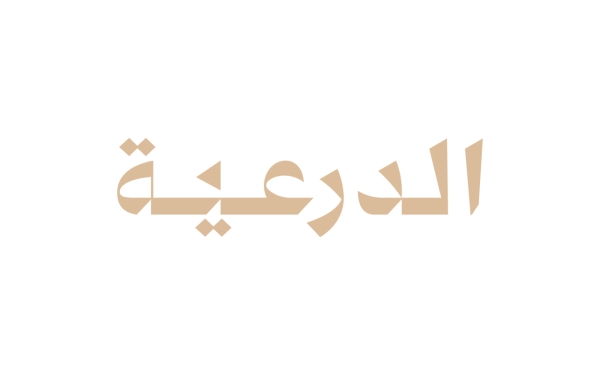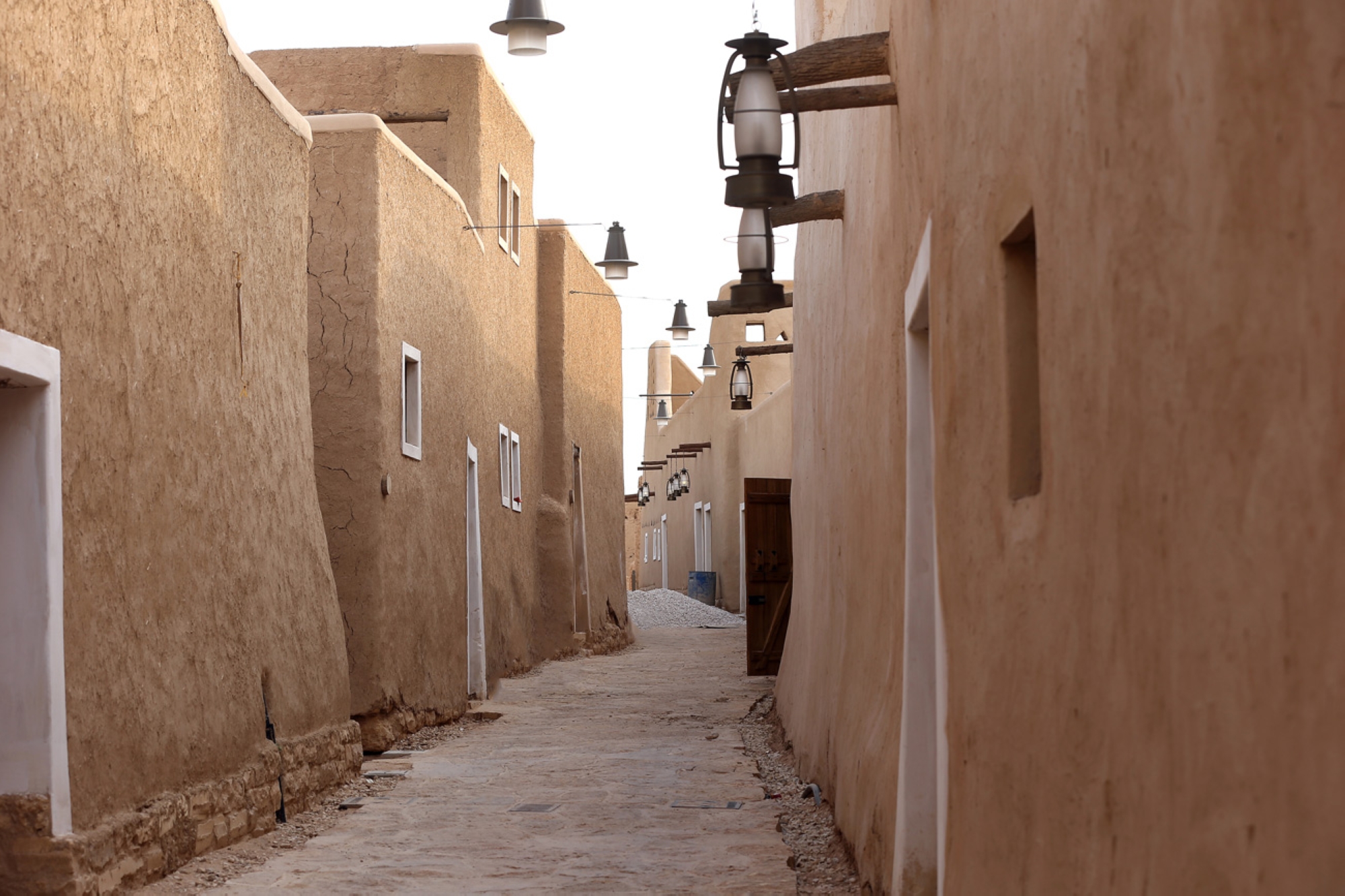


The Historic ad-Dir'iyyah Development Program is a national project to restore and reconstruct the historical ad-Dir'iyyah, once the capital of the First Saudi State, to become an integrated tourist and cultural destination. It is one of the programs of the Royal Commission for Riyadh City (RCRC).
The program was approved by a royal order on October 7, 1998, stipulating the establishment of a high commission for the development of ad-Dir'iyyah. This commission would be chaired by the chairman of the High Commission for the Development of Arriyadh (currently RCRC), alongside the membership of several representatives from government entities. The order also mandated that the RCRC take charge of implementing program plans, in collaboration with the General Authority for Tourism and Antiquities (currently the Ministry of Tourism) and the governor of ad-Dir'iyyah.
In 2019, Saudi Vision 2030 launched the ad-Dir'iyyah Gate Development Authority (DGDA), planned to attract 27 million domestic and international visitors by 2030. It supports the National Tourism Strategy that aims to host one hundred million tourists from around the world in the Kingdom by 2030.
The project was inaugurated by the Custodian of the Two Holy Mosques, King Salman Bin Abdulaziz Al Saud, in the presence of the Crown Prince and Prime Minister, His Royal Highness Prince Mohammed Bin Salman Bin Abdulaziz.
Significance of Historical ad-Dir'iyyah
Historical ad-Dir'iyyah represents significant cultural, historical, and political value, given its heritage and archaeological sites. It dates back three hundred years. It represented the seat of governance and the capital of the First Saudi State, from which the foundations of the modern Kingdom originated.
One of the development pillars of the Historic ad-Dir'iyyah Development Program is the preservation of the historical and urban characteristics of ad-Dir'iyyah, known today as Najdi architecture. This architectural style is epitomized in its palaces and buildings, shaping its distinct character. Another crucial aspect of the program is to achieve sustainable development in ad-Dir'iyyah, aligning with its environmental and natural elements, alongside promoting private investment for its development.
The strategy of the Historic ad-Dir'iyyahDevelopment Program includes stimulating private investments to participate in the development program, transforming ad-Dir'iyyah's archaeological and heritage areas into a cultural and civilizational hub at the national level, using old neighborhoods as basic models for urban and cultural development, and achieving sustainable development by preserving the natural ecological viability of historical sites.

Pillars of the Historical ad-Dir'iyyah Development Program
The program is based on the preservation of urban structures and their utilization as a center for various activities serving the archaeological area, as well as providing developmental components in the cultural, social, and economic aspects. The program also aims to encourage crafts, the development of traditional building techniques, and support tourism in terms of investment.
Implementation phases of the Historical ad-Dir'iyyah Development Program
The program is based on a two-phase implementation plan; main and supplementary. The main phase comprises three projects, namely: al-Turaif District Development Program, al-Bujairi Quarter Development Project, and the Road and Public Utilities Development Project. The RCRC is responsible for the planning, implementation, operation, and maintenance works, whereas the Ministry of Tourism operates and manages al-Turaif District, and attracts tourism and economic investments.
Al-Turaif District Development Program
Al-Turaif District Development Program is a major archaeological landmark in Historical ad-Dir'iyyah, encompassing historic buildings and palaces inhabited by the imams of the First Saudi State. One of the objectives of the development of the district is to highlight it as an archaeological site and register it as a World Heritage Site by the United Nations Educational, Scientific, and Cultural Organization (UNESCO). The district's registration is one of the aims of the ad-Dir'iyyah Gate, one of the projects of Saudi Vision 2030.
The district's registration on the UNESCO list was announced on July 29, 2010, at the World Heritage Committee meeting in Brasilia, Brazil.
The stages of the development of the district include the construction of a number of museums, including the Salwa Palace Museum, which aims to introduce the history of the First Saudi State through a series of museum components and appropriate activities contained in Salwa Palace (seat of governance at the time). The Social Life Museum is a museum specializing in shining the spotlight on social lifestyle during the First Saudi State. The Arabian Horse Gallery is comprised of two sections, the first contains antiquities and collections, and introduces Arabian horses, whereas the second is a venue for live horse performances. The Military Museum showcases means of war and defense, and war collectibles and antiquities. This comes in addition to the Museum of Commerce, the Museum of Treasury (Beit al-Maal), and the Traditional Architecture Museum.
Al-Turaif District Development Program is based on the construction of a number of administrative buildings, including a center for receiving visitors and introducing them to al-Turaif District; a research center named 'ad-Dir'iyyah History Documentation Center'; al-Turaif Administration Headquarters for managing the operation and organization of the district; and the restoration and rehabilitation of the archaeological Imam Mohammed Bin Saud Mosque to host prayers.
One of the projects of al-Turaif District development under ad-Dir'iyyah development program is the restoration and habilitation of some old buildings on one of the main streets to become a heritage market and a restaurant complex, along with connecting all the district buildings’ systems and events via a central information network. Other projects include regular sound-and-light performances, multimedia shows that tell the story of the First Saudi State using projectors on the walls of Salwa Palace and a number of sites in the district, in addition to landscaping public squares, lighting work, paving roads and causeways, and restoring mud buildings.

Al-Bujairi Quarter Development Project
Al-Bujiari Quarter is located on the eastern side of Hanifa Valley opposite to al-Turaif District. The quarter was home to Sheikh Mohammed Bin Abd al-Wahhab and his family, as well as students.
Al-Bujairi Quarter Development Project under the Historic ad-Dir'iyyah Development Program includes a series of projects that demonstrate the quarter's historical stature through modern institutions and establishments, namely the Sheikh Mohammed Bin Abd al-Wahhab Cultural Foundation – a scientific research institution specializing in Islamic Da'wah, planned to become an international research center serving researchers. The projects further include the development of the Sheikh Mohammed Bin Abd al-Wahhab Mosque, al-Dwaihra Mosque, and the development of ad-Dir'iyyah Park – connecting al-Bujairi Quarter with al-Turaif District – and the development of al-Bujairi Square, which is a venue for seasonal events and folkloric performances.
The Custodian of the Two Holy Mosques, King Salman Bin Abdulaziz Al Saud, inaugurated al-Bujairi Quarter Development Project on April 9, 2015. He toured the site to inspect project components and available facilities and services. He also laid the cornerstone for the Samhan Heritage Hotel and unveiled a plaque reading Historical ad-Dir'iyyah: A World Heritage Site, on the occasion of the site’s accession to the UNESCO World Heritage List.
Related quizzes
Related articles

